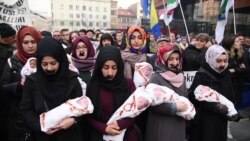Sarajevo's Muslim, Catholic, Orthodox Christian, and Jewish communities came together this week in the Bosnian capital to send a message of solidarity to the battered and beleaguered Syrian city of Aleppo. More than 1,000 people took part in the somber show of support on December 14.
While a number of cities around the world have joined the #StandWithAleppo movement, few places can feel the pain of Aleppo's civilians as acutely as Sarajevo. That city was besieged and shelled by ethnic Serb forces from April 1992 to February 1996. About 14,000 people were killed, and some 350,000 civilians endured the 1,400-day horror, wondering whether the outside world knew or cared about their plight.
The head of the Sarajevo Jewish community, Eli Tauber, was one of the speakers at this week's event. He reminded people of Europe in 1933, when the Nazis took power in Germany and the seeds of the Holocaust were sown. He spoke about the 1990s Bosnian war, which took over 100,000 lives.
"We have moral obligation to raise our voices," Tauber said. "Aleppo is a test of humanity. We should not be mere observers of the tragedy; we must act."
Also among the speakers at the Sarajevo rally was Franjo Topic, head of the Napredak Bosnian Croat Cultural Center.
"We want to inspire humanitarian organizations to provide assistance to Aleppo," he said. "There is no holy war; there is only holy peace."
The Islamic community was one of the organizers of the Sarajevo demonstration and got several nongovernmental organizations to join them in speaking out on behalf of Aleppo's victims.
I myself survived the siege of Sarajevo, working as a journalist and editor of the daily newspaper Oslobodjenje. Every day we feared we were printing the last issue of our newspaper. Our elegant, twin-towered building on the outskirts of the city was ultimately reduced to ruins by constant Serb shelling. The newspaper moved to an underground bunker. We coped somehow with a lack of electricity, of newsprint, of food.
I recall a colleague, photographer Salko Hondo, who had retired just before the outbreak of war, returning to work once the fighting started. I also remember that he avoided going to the front lines, preferring to take assignments in the center of the city, where it was supposedly safer.
In the summer of 1992, we received a tip that a man had discovered a water source in his backyard near the Ciglane market. Parched Sarajevans rushed to get water and Salko offered to go photograph the scene.
On his way back to our bunker, Salko was caught in a shelling of the Ciglane market. Eight people were killed and more than 20 wounded. Salko Hondo was killed on the spot. We manage to retrieve his camera. I remember the next day’s edition of Oslbodjenje, July 17, carried both Salko's obituary and his last photo -- happy Sarajevans pouring water into canisters.
When I look at photos of Aleppo now, I am carried back to that time -- one when there were no safe places and it was hard not to feel alone and forgotten. I know how short the distance is between Sarajevo and Aleppo.






